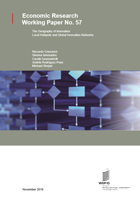The Geography of Innovation: Local Hotspots and Global Innovation Networks
Economic Research Working Paper No. 57
Author: Riccardo Crescenzi
Author: Simona Iammarino
Author: Carolin Ioramashvili
Author: Andrés Rodríguez-Pose
Author: Michael Storper
Publication year: 2019
DOI: English

Through successive industrial revolutions, the geography of innovation around the globe has changed radically, and with it the geography of wealth creation and prosperity. Since the Third Industrial Revolution, high incomes are increasingly metropolitan, leading to a renewal of inter-regional divergence within countries. These metropolitan areas are also hotbeds of innovation. At the same time, global networks for the production and delivery of goods and services have expanded greatly in recent decades. The globalization of production is mirrored in the globalization of innovation. This paper argues that the emerging geography of innovation can be characterised as a globalized hub-to-hub system, rather than a geography of overall spread of innovation. Although much attention has been given to explaining the rise and growth of innovation clusters, there is as yet no unified framework for the micro-foundations of the agglomeration and dispersion of innovation. In addition, there appear to be strong links between growing geographical inequality of innovation and prosperity, particularly within countries. This is particularly relevant in the context of declining overall research productivity, which could be driving growing geographical concentration. All in all, there is a rich agenda for continuing to investigate the relationship between the geography of innovation, economic development and income distribution.
